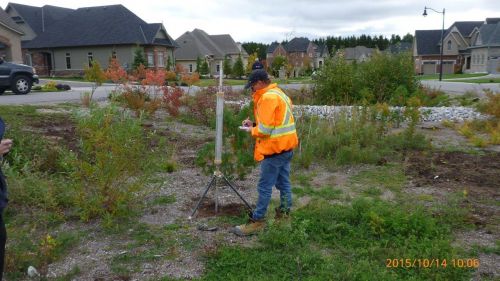Infiltration
Infiltration of stormwater into underlying soils is one the priority level 1. mechanisms to achieve MOECC Runoff Volume Control targets.
Infiltration is promoted through a number of LID BMPs:
- Infiltration chambers and trenches (underground)
- Infiltration basins (surface)
- Bioretention cells (surface)
- Bioswales (surface)
Constraints[edit]
Infiltration practices are not recommended:
- Where the bedrock is within 1 m below the bottom of the proposed BMP,
- Where the seasonal high groundwater level comes within 1 m below the bottom of the proposed BMP,
Or in areas where increased infiltration will result in elevated groundwater levels, which can be demonstrated to damage critical utilities or private property, - Over swelling clays or unstable sub-soils,
- Over contaminated soils or sites with high risk of contamination from onsite activities,
- In flood prone areas where the wastewater system is sensitive to groundwater conditions causing sewer backups, and where LID BMPs have been found to be ineffective,
- In areas where the ecology and natural hydrology are dependent upon surface water,
- Where prohibitions and/or restrictions exist per approved Source Protection Plans (see MOECC guidance).
Infiltration can still be optimized over 'tight' soils with infiltration rates ≤ 15 mm/hr:
Without infiltration, many LID design alternatives exist which can still capture and retain stormwater:
Planning[edit]
Soil Infiltration Testing
Infiltration tests must be undertaken at the location, depth and with a head of water that replicates the proposed design.
Four Step Process[edit]
Soil infiltration testing is a four-step process to obtain the necessary information for stormwater management planning and design. The four steps include:
1. Background Evaluation
- Based on available published and site specific data;
- Includes consideration of proposed development plan;
- Used to identify potential BMP types, locations and soil test locations;
- Done prior to field work; and
- On-site soil tests may be done to identify/screen potential BMP locations.
2. Test Pit or Soil Boring Observations
- Includes multiple testing locations;
- Provides an understanding of sub-surface conditions; and
- Identifies limiting conditions (e.g., aquitard, bedrock or water table elevations).
- Must be conducted on-site;
- Various testing methods are available; and
- Different testing methods for screening versus verification purposes.
- Determination of a suitable infiltration rate for design calculations; and
- Consideration of desired BMP drainage time.
Test Pit or Soil Boring Observations[edit]
Test pits or soil borings provide information regarding the soil horizons and overall soil conditions both horizontally and vertically in that portion of the site. Multiple observations can be made across a site at a relatively low cost and in a short time period.
Test pit excavations or soil borings should extend to a depth of between 2.5 - 5 m below ground surface or until bedrock or fully saturated conditions are encountered. It is important that the tests provide information related to conditions at least 1.5 m below the proposed bottom elevation of the infiltration BMP. Test pit trenches should be benched at 1 m depth intervals for access and infiltration testing.
At each test location, the following conditions should be noted and described:
- Soil horizons (upper and lower boundary);
- Soil texture and colour for each horizon;
- Color patterns (mottling) and observed depth;
- Depth to water table (if encountered);
- Depth to bedrock (if encountered);
- Observations of pores or roots (size, depth);
- Estimated type and percent coarse fragments;
- Hardpan or other limiting layers; and
- Strike and dip of soil horizons.
External links[edit]
For further information on Borehole observation and test pits please visit the following external links:
- Oak Ridges Moraine Groundwater Management
- Northern Development, Mines, Natural Resources and Forestry's Open Data site for Geotechnical Boreholes
- Northern Development, Mines, Natural Resources and Forestry's Open Data site for Geotechnical Boreholes
- Geological Survey of Canada's Borehole Geophysical Logs
Groundwater
The bottom of the infiltration BMP must ≥ 1 m vertically separated from the seasonally high water table, and underlying bedrock. This reduces the risk of contaminating groundwater and helps to ensure reliable infiltration rates throughout the year.
| Catchment area | Consequence of failure | ||
|---|---|---|---|
| No damage or inconvenience | Minor damage or inconvenience to external structures (e.g. ponding in parking lot) | Significant damage to buildings or infrastructure (e.g. flooding damage) | |
| <100 m2 | 1.5 | 2 | 10 |
| 100 - 1000 m2 | 1.5 | 3 | 10 |
